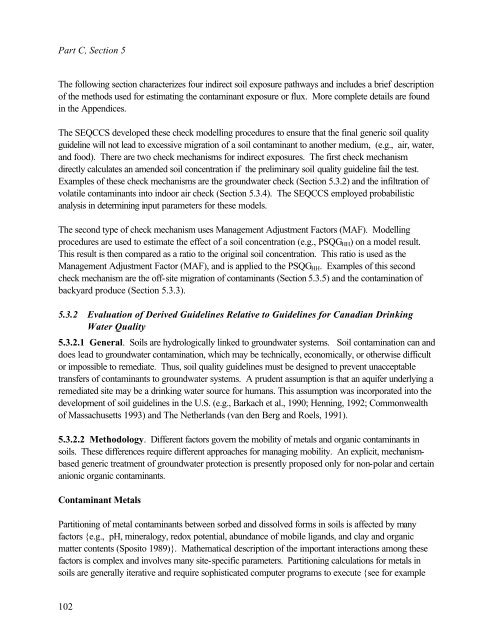Protocol for the Derivation of Environmental and Human ... - CCME
Protocol for the Derivation of Environmental and Human ... - CCME
Protocol for the Derivation of Environmental and Human ... - CCME
Create successful ePaper yourself
Turn your PDF publications into a flip-book with our unique Google optimized e-Paper software.
Part C, Section 5<br />
The following section characterizes four indirect soil exposure pathways <strong>and</strong> includes a brief description<br />
<strong>of</strong> <strong>the</strong> methods used <strong>for</strong> estimating <strong>the</strong> contaminant exposure or flux. More complete details are found<br />
in <strong>the</strong> Appendices.<br />
The SEQCCS developed <strong>the</strong>se check modelling procedures to ensure that <strong>the</strong> final generic soil quality<br />
guideline will not lead to excessive migration <strong>of</strong> a soil contaminant to ano<strong>the</strong>r medium, (e.g., air, water,<br />
<strong>and</strong> food). There are two check mechanisms <strong>for</strong> indirect exposures. The first check mechanism<br />
directly calculates an amended soil concentration if <strong>the</strong> preliminary soil quality guideline fail <strong>the</strong> test.<br />
Examples <strong>of</strong> <strong>the</strong>se check mechanisms are <strong>the</strong> groundwater check (Section 5.3.2) <strong>and</strong> <strong>the</strong> infiltration <strong>of</strong><br />
volatile contaminants into indoor air check (Section 5.3.4). The SEQCCS employed probabilistic<br />
analysis in determining input parameters <strong>for</strong> <strong>the</strong>se models.<br />
The second type <strong>of</strong> check mechanism uses Management Adjustment Factors (MAF). Modelling<br />
procedures are used to estimate <strong>the</strong> effect <strong>of</strong> a soil concentration (e.g., PSQG HH ) on a model result.<br />
This result is <strong>the</strong>n compared as a ratio to <strong>the</strong> original soil concentration. This ratio is used as <strong>the</strong><br />
Management Adjustment Factor (MAF), <strong>and</strong> is applied to <strong>the</strong> PSQG HH . Examples <strong>of</strong> this second<br />
check mechanism are <strong>the</strong> <strong>of</strong>f-site migration <strong>of</strong> contaminants (Section 5.3.5) <strong>and</strong> <strong>the</strong> contamination <strong>of</strong><br />
backyard produce (Section 5.3.3).<br />
5.3.2 Evaluation <strong>of</strong> Derived Guidelines Relative to Guidelines <strong>for</strong> Canadian Drinking<br />
Water Quality<br />
5.3.2.1 General. Soils are hydrologically linked to groundwater systems. Soil contamination can <strong>and</strong><br />
does lead to groundwater contamination, which may be technically, economically, or o<strong>the</strong>rwise difficult<br />
or impossible to remediate. Thus, soil quality guidelines must be designed to prevent unacceptable<br />
transfers <strong>of</strong> contaminants to groundwater systems. A prudent assumption is that an aquifer underlying a<br />
remediated site may be a drinking water source <strong>for</strong> humans. This assumption was incorporated into <strong>the</strong><br />
development <strong>of</strong> soil guidelines in <strong>the</strong> U.S. (e.g., Barkach et al., 1990; Henning, 1992; Commonwealth<br />
<strong>of</strong> Massachusetts 1993) <strong>and</strong> The Ne<strong>the</strong>rl<strong>and</strong>s (van den Berg <strong>and</strong> Roels, 1991).<br />
5.3.2.2 Methodology. Different factors govern <strong>the</strong> mobility <strong>of</strong> metals <strong>and</strong> organic contaminants in<br />
soils. These differences require different approaches <strong>for</strong> managing mobility. An explicit, mechanismbased<br />
generic treatment <strong>of</strong> groundwater protection is presently proposed only <strong>for</strong> non-polar <strong>and</strong> certain<br />
anionic organic contaminants.<br />
Contaminant Metals<br />
Partitioning <strong>of</strong> metal contaminants between sorbed <strong>and</strong> dissolved <strong>for</strong>ms in soils is affected by many<br />
factors {e.g., pH, mineralogy, redox potential, abundance <strong>of</strong> mobile lig<strong>and</strong>s, <strong>and</strong> clay <strong>and</strong> organic<br />
matter contents (Sposito 1989)}. Ma<strong>the</strong>matical description <strong>of</strong> <strong>the</strong> important interactions among <strong>the</strong>se<br />
factors is complex <strong>and</strong> involves many site-specific parameters. Partitioning calculations <strong>for</strong> metals in<br />
soils are generally iterative <strong>and</strong> require sophisticated computer programs to execute {see <strong>for</strong> example<br />
102
















